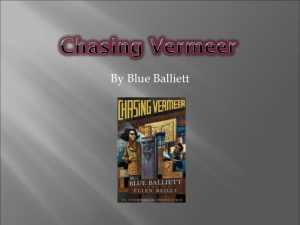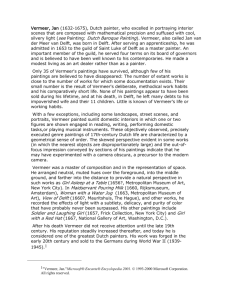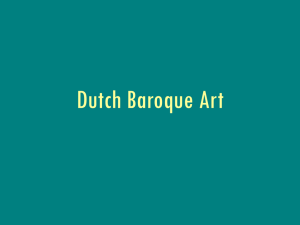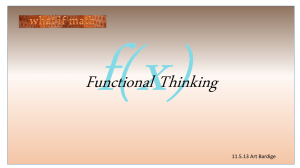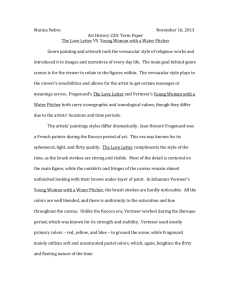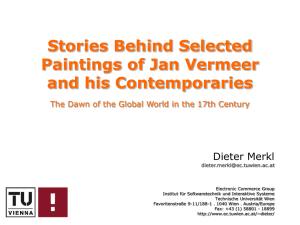WORD Document - Essential Vermeer
advertisement
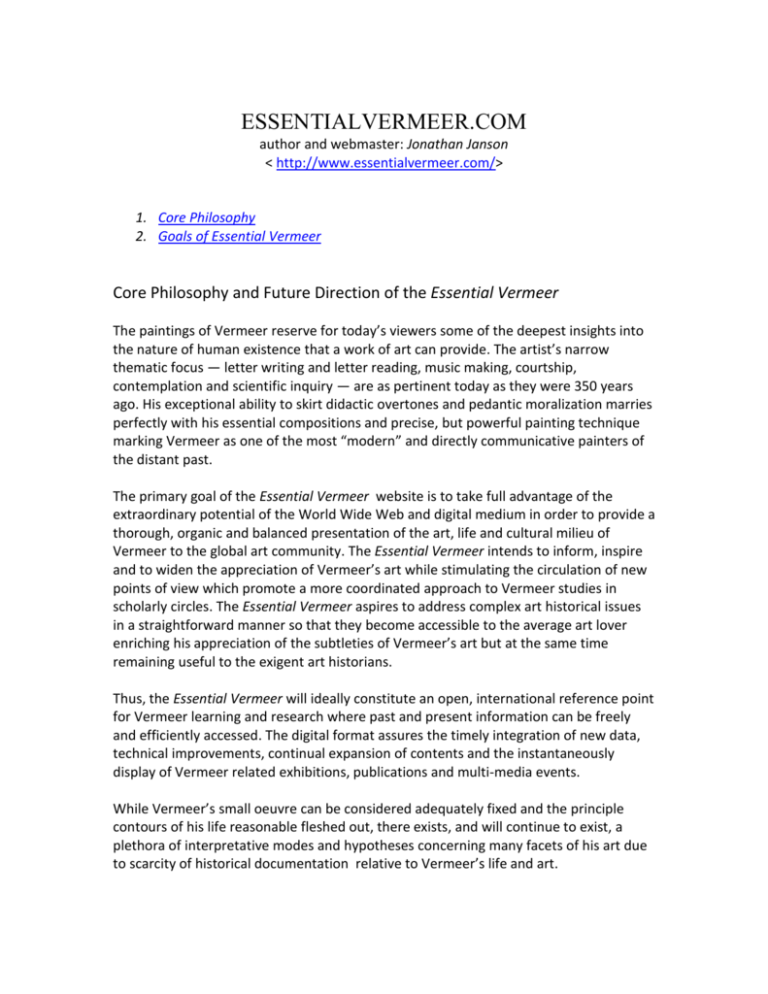
ESSENTIALVERMEER.COM author and webmaster: Jonathan Janson < http://www.essentialvermeer.com/> 1. Core Philosophy 2. Goals of Essential Vermeer Core Philosophy and Future Direction of the Essential Vermeer The paintings of Vermeer reserve for today’s viewers some of the deepest insights into the nature of human existence that a work of art can provide. The artist’s narrow thematic focus — letter writing and letter reading, music making, courtship, contemplation and scientific inquiry — are as pertinent today as they were 350 years ago. His exceptional ability to skirt didactic overtones and pedantic moralization marries perfectly with his essential compositions and precise, but powerful painting technique marking Vermeer as one of the most “modern” and directly communicative painters of the distant past. The primary goal of the Essential Vermeer website is to take full advantage of the extraordinary potential of the World Wide Web and digital medium in order to provide a thorough, organic and balanced presentation of the art, life and cultural milieu of Vermeer to the global art community. The Essential Vermeer intends to inform, inspire and to widen the appreciation of Vermeer’s art while stimulating the circulation of new points of view which promote a more coordinated approach to Vermeer studies in scholarly circles. The Essential Vermeer aspires to address complex art historical issues in a straightforward manner so that they become accessible to the average art lover enriching his appreciation of the subtleties of Vermeer’s art but at the same time remaining useful to the exigent art historians. Thus, the Essential Vermeer will ideally constitute an open, international reference point for Vermeer learning and research where past and present information can be freely and efficiently accessed. The digital format assures the timely integration of new data, technical improvements, continual expansion of contents and the instantaneously display of Vermeer related exhibitions, publications and multi-media events. While Vermeer’s small oeuvre can be considered adequately fixed and the principle contours of his life reasonable fleshed out, there exists, and will continue to exist, a plethora of interpretative modes and hypotheses concerning many facets of his art due to scarcity of historical documentation relative to Vermeer’s life and art. Rather than attempting to resolve discrepancies among conflicting positions, I believe that the Essential Vermeer can more productively serve the collective interests of the art community by furnishing a neutral vantage point were all significant sides are divulged in a balanced manner. The availability of multiple viewpoints will encourage further inquiry and promote more informed discussions. My personal viewpoint will be expressed via a special blog, Essential Vermeer Time. As in the past, I will continue to be keen on exchanging experiences and expertise with international colleagues and institutions and deepening collaborative relationships which concern not only Vermeer-related studies but the development of internet- and art-historical strategies in general. GOALS OF ESSENTIAL VERMEER Short Term Goals The short term goals of the Essential Vermeer comprise immediate technological enhancements to keep pace with internet evolution as well as additions, reedits and updates of key areas of content interest. CONTENTS 1. Videos on Vermeer and related subjects One of the most promising yet overlooked means of communication by the art history community is the digital video which is instead enjoying an unsurpassed diffusion on the internet today. The immediacy of video communication is adapted not only for conveying news events in a timely manner but also for conveying the subtleties of the subjective engagement with the work of art. In particular, I would like to employ video to express my own personal experiences with Vermeer’s art and Dutch painting in general in order to evidence nuances of meaning. My plan is to create a series of five short videos which introduce the fundamental issues of Vermeer’s complex art followed by a video dealing with each of the artist’s 37 canvases in order to illuminate particular aspects which have been overlooked by academic circles. I feel that in this area, my 40 year experience as a painter and in-depth studies of Vermeer’s painting technique will prove beneficial to drawing the average viewer closer to the heart of this master’s exceptional oeuvre. 2. A study of the women who appear in Vermeer’s painting related to Dutch women of the seventeenth-century. Vermeer, more than any painter of his time, turned his attention on the life of women. He investigates with utmost delicacy not only their elegant, outward appearances but their psyche which constitutes one of the greatest testimonies to female thought ever produced by an artist. Art scholars have correlated this new interest with the status of Dutch women of the seventeenth century who enjoyed a privileged status in respects to women of other European countries. 3. Enhance the Essential Vermeer art glossary with particular attention to terminology related to the work of Vermeer and Dutch 17th-century painting. 4. Research and elaborate an illustrated overview of the School of Delft. 5. Research and elaborate an illustrated overview of 17th-century art theory with the accent on its relevance to the art of Vermeer. 6. Research and elaborate an overview of the history of public and scholarly appreciation of Vermeer’s art. 7. Research and elaborate an illustrated overview of Dutch interior painting. 8. Create introductory audio-visual video presentations for every painting by Vermeer. 9. Convert the present HTML code of Essential Vermeer to JOOMLA to facilitate social networking and rapid expansion. 10. Relocate the Essential Vermeer to a higher-quality hosting. The improved hosting will limit down-time and upload time necessary for the display of high resolution digital images which become widely available. Medium Term Goals One of the most promising areas of Vermeer studies regards the artist’s painting materials and technique. New scientific instruments and conservational methods have furnished extraordinary insights into Vermeer’s working methods improving our understanding of his artistic goals. 1. A painted reconstruction of an extant Vermeer to demonstrate the artist’s painting methods and materials. During the arc of reconstruction process, the canvas will be photographed at intervals in order to evidence each significant evolution of the image. To clarify key painting techniques, the main body of sequential images will be enhanced by additional step-by step images of pertinent technical procedures such as glazing, scumbling, wet-in-wet routinely exploited in the painting of Vermeer as well as optical effects such as the turbid medium effect. When completed, selected sequential hi-res images will be accompanied by explanatory text and presented in HTML format on the Essential Vermeer website. The choice of painting will be determined considering its state of conservation, stylistic/technical complexity as well as the availability of relative curatorial records and, importantly, the possibility of interaction with conservation personnel. At the present, the most promising works for this project are the Lady Writing (National Gallery of Art, Washington DC), Woman Holding a Balance (National Gallery of Art, Washington DC), Woman Holding a Water Pitcher (Metropolitan Museum of Art) or Woman Standing at the Virginals (National Gallery, London). All three works present a relatively integral paint surface and display evidence of the four-step technique painting method employed by seventeenth-century Dutch history painters and Leiden fijnschilders. This method is documented in period Dutch artists’ manuals and in the case of Vermeer’s work, largely confirmed by extant scientific evidence. Whenever possible and advantageous, original painting materials, such as mediums and pigments, will be employed. 2. A study of the background walls in Vermeer’s interiors. A little discussed, yet crucial component of Vermeer’s motifs are the unobtrusive white-washed walls that set the stage for the artist’s quit dramas. Vermeer’s walls have multiple functions and, in effect, constitute a technical tour de force unique in Western easel painting. They not only define the pictures’ threedimensional limits but establish with uncanny precision each work’s lighting scheme and often play a crucial role in compositional organization. Vermeer employed subtle and sundry pictorial strategies to define each wall’s particular illusionist qualities while maintaining the transparency of cast shadows. Their hue establishes the temperature of the incoming light while chiaroscural values and brushwork signal the light’s direction, intensity as well as the wall’s material texture. Surprisingly, the pigment combinations he and other Dutch interior painters generally used for this task were few; mainly lead white, black and raw umber, a workhorse, but unexciting brown. The importance that Vermeer attached to evoking their luminosity is confirmed by the well-known findings that he deliberately introduced in some of his wall mixtures minute quantities of lapis lazuli blue which introduces a breath of airiness. Brushwork, the colored ground and paint layering also had a considerable effect on the correct reading of the walls’ uneven textures. One of the most problematic aspects of the depiction of Vermeer’s walls was controlling the gradation of light to darker gray paint as the light rakes across the walls’ surface from left to right. This gradation, which appears so natural that they are taken for granted, are not only a product of chiaroscural values but of the correct proportions of the base pigments. It would be instructive to match selected samples of Vermeer’s walls with in situ paint sample employing those pigments known to be present in the wall mixtures. Another point of interest is at what point in the painting process did Vermeer executed the walls. One hypothesis would be the background wall should be painted first much as Dutch landscape painters were advised to paint the sky before the landscape since it is the sky’s light which influences the coloring and chiaroscural values of the landscape and not the other way around. Another might be that Vermeer adopted the practiced scheme of painting from the depths of the picture towards the front. It is my intention to open a dialogue with conservators regarding the pigments and techniques used in the some of the most characteristic and well-conserved background walls of Vermeer. This project would involve travel, lodging and painting material expenses. This illustrated study will be published in html format on the Essential Vermeer website. 3. A comparative study of Vermeer’s pictures-within-pictures. When depicting the so-called pictures-within-picture, the vast majority of Dutch painters took a somewhat unthinking attitude. They generally adopted an analogous style to that used in the rest of the composition whereby the level of detail in depicting the picture-within-a-picture was the same of work in which they were inserted. This oversight occasionally gave rise to some rather amusing effects where for example, in the many works which display an artist making a portrait in his studio (see Frans van Mieris), the bust-length portrait that sets on the artist’s easel appears oddly real, or more so, than that of the sitter. Although Dutch painters excelled in the description of appearances, and especially textures, we have the impression that they did not fully grasp that fact that observation and unfaltering attention to detail does not always guarantee the most natural end effect. While they produced uncanny portrayals of light and texture, the essential visual quality of a painting-with-a-painting, its flatness, had substantially escaped their attention and does not appear to have been codified. Instead, Vermeer was well aware of the picture-within-a-picture's characterizing qualities and experimented with various techniques to make this “clear” to the viewer. This study will examine the subtleties of technique and style, the illusionist consequences of Vermeer’s pictures-within-pictures as well as analogous stylistic approaches used by close Dutch colleagues. This illustrated study will be published in html format on the Essential Vermeer website. Long Term Goals 1. Vermeer Database In the long term, it is one of Essential Vermeer’s goal to create an in-depth database which integrates the broadest possible range of conservational, technical, stylistic, historical and iconographical information regarding every aspect of the life and art of Vermeer. The database would be integrated into and accessible via studies already in place throughout the Essential Vermeer website. It would also be accessible independently. The Vermeer Database would interface with analogous institutional and museum databases and, hopefully, serve as a model for further databases of individual Dutch painters. The Vermeer Database would follow the guiding principle of stimulating the use of open source solutions in order to achieve the greatest possible scholarly and educational benefit. Similar to the Rembrandt Database in development, recorded data can be aggregated by others, making it possible to build multiinstitutional online databases on subjects across collections and institutional boundaries without having to rerecord the data. 2. Enhanced Vermeer Newsletter One of the most innovative and fruitful features of the Essential Vermeer website is a free-of-charge, email newsletter which diffuses all Vermeer-related publications, exhibitions, conferences, news and multi-media events. The current mailing list comprises over 3,000 subscribers, many of whom are Dutch and Flemish art curators, scholars, conservators, writers and related specialists. Through my individual efforts, flanked by the enthusiastic support of scholars and art institution personnel, the Vermeer Newsletter not only furnishes information for Vermeer enthusiasts but serves as a efficient vehicle that bridges the gap between Dutch-art specialists so that findings and writings can circulate in a more capillary and timely manner. In view of the success of the Vermeer Newsletter, its usefulness could be greatly enhanced by expanding its present focus from Vermeer to the much wider field of 17th-century Dutch genre painting. With the growth of the present newsletter database, the present mass-mailing interface a new application to insure greater flexibility and greater efficacy in the future. The newsletter database will also be widened from individual subscribers to art institutions and study groups. 3. Once the Vermeer Database and Essential Vermeer website are sufficiently developed, the site’s content will be expanded to cover 17th-century Dutch interior painting in general concentrating of the principle exponents Gerrit Dou, Frans van Mieris and Gerard ter Borch. The Essential Vermeer Now Launched June 1, 2001, the Essential Vermeer presently comprised scores of Vermeerrelated studies with over 500 individual web pages, 3,000 images, 200 audio files, bibliographies, interviews with Vermeer notables and interactive studies. It receives approximately 500,000 unique visits and 3,500,000 page views a year. It is free-access and non-commercial. The Essential Vermeer is authored, maintained and financed by Jonathan Janson. The Essential Vermeer has become a prime internet resource for Vermeer studies routinely referenced by Vermeer and Dutch specialists as well as art writers and one of the principle venues for promoting upcoming Vermeer-related events, exhibitions, writings and art historical findings. In recent years, the website and its author have been cited in Vermeer-related books, essays and films from Walter Liedtke’s recent Vermeer: The Complete Paintings to Timothy Brook’s Vermeer's Hat: The Seventeenth Century and the Dawn of the Global World and the film documentary by Hans Pool, Views on Vermeer: 12 Stories. The website’s newsletter disseminates all Vermeer-related news, including exhibitions, publications and multi-media events and is distributed free of charge to over 3,000 subscribers, many of whom are Dutch art specialists.

